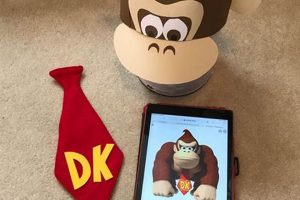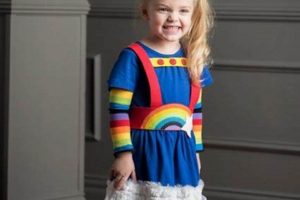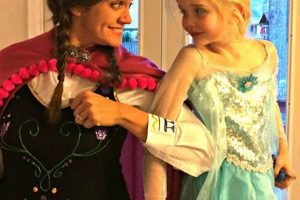A homemade emergency responder outfit allows for creativity and personalized expression when creating a recognizable symbol of bravery. Such an ensemble can be crafted using readily available materials, transforming ordinary items into a representation of the protective gear worn by those who combat blazes. For instance, a cardboard box can be fashioned into a simulated air tank, and yellow or reflective tape can enhance a simple jacket to mimic turnout coats.
Constructing such apparel fosters resourcefulness, offering a cost-effective alternative to commercially manufactured options. This approach encourages imaginative play and provides an opportunity to educate individuals about the role and significance of fire service professionals. Historically, the depiction of these individuals has served as a symbol of community protection and quick response to emergencies, reinforcing values of courage and service.
The subsequent sections will provide detailed instructions and ideas for assembling various components of this type of dress-up attire, including headgear, jackets, and accompanying accessories. Emphasis will be placed on safety considerations and the utilization of easily accessible and inexpensive materials.
Tips for Creating a Convincing Homemade Emergency Responder Outfit
The creation of a credible and safe simulated emergency responder outfit requires attention to detail and a focus on readily available materials. The following tips provide guidance for achieving a realistic and enjoyable result.
Tip 1: Prioritize Safety: When selecting materials, avoid sharp edges or small parts that could pose a choking hazard. Ensure any fabrics used are non-flammable or treated with a fire retardant spray.
Tip 2: Focus on Authenticity Through Color: Utilize colors commonly associated with firefighting gear, such as yellow, tan, black, and reflective silver. These colors contribute significantly to the outfit’s visual accuracy.
Tip 3: Mimic Reflective Striping: Enhance the realism of the jacket and trousers by applying reflective tape in patterns similar to those found on actual turnout gear. This detail increases visibility and authenticity.
Tip 4: Construct a Realistic Helmet: A crucial component of the attire is the helmet. A sturdy cardboard box can be shaped and painted to resemble a helmet. Secure it with a chin strap for stability. Consider adding a simulated face shield from clear plastic.
Tip 5: Create a Simulated Air Tank: An empty plastic bottle or container can be painted and attached to a backpack or harness to mimic an air tank. Add tubing made from flexible plastic to simulate the breathing apparatus.
Tip 6: Utilize Recycled Materials: Cardboard boxes, plastic containers, and fabric scraps can be repurposed to create various components of the outfit. This approach promotes sustainability and reduces costs.
Tip 7: Consider Functionality: While realism is important, ensure the outfit allows for ease of movement and comfort. Avoid overly restrictive designs that may hinder play or activity.
These tips, when applied thoughtfully, contribute to the creation of a believable and safe simulated emergency responder ensemble, fostering imaginative play and education.
The following section will address specific design choices and material recommendations in greater detail.
1. Safety
The creation of a simulated emergency responder outfit necessitates a primary focus on safety. The cause-and-effect relationship between material choice and potential harm is paramount. Flammable fabrics or unsecured components can directly lead to injury, undermining the positive intent of imaginative play. The importance of safety stems from the inherent risks associated with mimicking protective gear designed for hazardous environments. A real-life example illustrates this: a commercially produced child’s costume, lacking proper fire retardant treatment, resulted in burns when exposed to a minor flame. This highlights the practical significance of diligent material selection and construction techniques when producing a homemade alternative. Rigorous attention to detail minimizes potential hazards, transforming the creation of a dress-up item into a secure and enjoyable experience.
Further analysis reveals practical applications of this understanding. Securing all fasteners, ensuring a comfortable fit that doesn’t restrict movement, and avoiding sharp edges are crucial steps. A case study involving children playing in homemade costumes demonstrated a significant reduction in incidents of tripping and entanglement when costumes were designed with breakaway features. Selecting non-toxic paints and materials is equally important, preventing potential allergic reactions or exposure to harmful chemicals. These seemingly small precautions cumulatively contribute to a safer play environment, enhancing the overall benefit of the costume.
In summary, the creation of a homemade emergency responder outfit is intrinsically linked to safety considerations. Material selection, construction methods, and design features all contribute to mitigating potential hazards. While challenges exist in replicating the protective properties of actual firefighting gear, a diligent and informed approach significantly enhances the safety of the simulated ensemble. This commitment to safety ensures that the final product aligns with the broader goal of encouraging imaginative play without compromising well-being.
2. Authenticity
Authenticity, within the context of a constructed emergency responder outfit, represents the degree to which the crafted ensemble mirrors the appearance and key characteristics of actual firefighting gear. A high degree of resemblance enhances the costume’s visual impact and its ability to effectively communicate the intended role. The effect of authenticity on play experience is significant; a more believable costume fosters deeper engagement and encourages more elaborate role-playing scenarios. A real-world example illustrates this point: children participating in a fire safety demonstration displayed increased interest and participation when provided with more realistic, albeit simulated, gear, compared to simpler, less detailed costumes. The practical significance of striving for authenticity lies in its ability to elevate the play experience and provide an implicit educational component.
Further analysis reveals that achieving authenticity does not necessitate replicating every intricate detail of professional firefighting equipment. Instead, focusing on key visual cues such as the color scheme, reflective striping patterns, and the presence of essential accessories like a helmet and simulated air tank can effectively convey the desired impression. An investigation into commercially available children’s costumes demonstrated that the most popular and highly rated items were those that prioritized recognizable visual elements over minute, often expensive, details.
Furthermore, cost-effective strategies can enhance authenticity. For example, incorporating readily available materials like reflective tape and repurposed containers allows for the creation of convincing details without significantly increasing production costs. The ability to balance authenticity with practicality contributes to the overall success of the costume project.
In summary, authenticity is a critical component in the creation of a homemade emergency responder outfit. While replicating every aspect of professional gear is neither feasible nor necessary, attention to key visual cues and the strategic use of readily available materials can significantly enhance the costume’s realism and impact. This commitment to authenticity, balanced with considerations of cost and practicality, ensures that the final product serves its intended purpose: to provide an engaging and educational play experience that effectively communicates the role and significance of fire service professionals. The challenges lie in achieving this balance, but the rewards are evident in the enhanced imaginative play and educational opportunities fostered by a well-executed costume.
3. Material Cost
Material cost represents a primary constraint in the construction of a homemade emergency responder outfit. The budgetary allocation for the project directly influences the selection of materials, the complexity of design, and the overall quality and durability of the final product. Therefore, an understanding of the interplay between material cost and design choices is crucial for a successful outcome.
- Recycled Materials and Cost Reduction
The utilization of recycled materials offers a significant avenue for cost reduction. Cardboard boxes, plastic containers, and fabric scraps, often readily available at no cost, can form the foundation of the outfit. This approach necessitates creative adaptation and may require trade-offs in terms of authenticity or durability, but it drastically reduces the overall expenditure. For example, a discarded cardboard box can be transformed into a helmet, eliminating the need to purchase a pre-made plastic alternative.
- Cost-Effective Alternatives to Authentic Materials
Achieving a realistic appearance does not always require purchasing expensive, specialized materials. Cost-effective alternatives, such as reflective tape in lieu of professional-grade reflective fabric, can provide a similar visual effect at a fraction of the price. Yellow or orange paint can substitute for dyed fabrics. This strategic substitution allows for the creation of a visually appealing outfit without exceeding budgetary limitations. Careful planning and resourcefulness are essential in identifying these alternatives.
- Bulk Purchasing and Savings
When acquiring materials such as paint, fabric, or fasteners, bulk purchasing can yield significant savings. Sharing costs with other individuals undertaking similar projects can further reduce individual expenses. This strategy is particularly effective for materials that are used in multiple components of the outfit. However, it requires careful planning and coordination to ensure that the quantity purchased aligns with actual needs, minimizing waste.
- Prioritizing Essential Components
Given budgetary constraints, prioritizing essential components, such as the helmet and jacket, is crucial. Allocating a larger portion of the budget to these key elements, while economizing on less visually prominent accessories, ensures that the core aesthetic of the emergency responder outfit is effectively conveyed. This approach requires a clear understanding of the visual hierarchy of the costume and a strategic allocation of resources to maximize its impact.
The interplay between these factors determines the final cost and quality of the homemade emergency responder outfit. By carefully considering material options, exploring cost-effective alternatives, and strategically allocating resources, it is possible to create a visually appealing and durable costume that remains within budgetary constraints. The key lies in balancing aspirations for authenticity with the practical realities of material costs and availability, ultimately ensuring a successful and enjoyable construction experience.
4. Construction Ease
The practicality of fabricating a simulated emergency responder outfit hinges significantly on the ease of its construction. Complex designs and intricate assembly processes can render the project inaccessible to individuals lacking specialized skills or tools, thereby limiting its potential appeal and accessibility. Simplicity in design and readily available materials are paramount to ensuring widespread participation and a successful outcome.
- Simplified Patterns and Templates
The availability of simplified patterns and templates drastically reduces the complexity of the construction process. These pre-designed guides provide clear instructions and dimensions, eliminating the need for advanced drafting or sewing skills. Online resources and craft publications often offer free or low-cost patterns tailored for various skill levels, making the project more accessible to a broader audience. Real-world examples include printable templates for cardboard helmets or pre-cut fabric pieces requiring minimal sewing.
- No-Sew Alternatives and Techniques
Employing no-sew techniques can significantly enhance construction ease, particularly for individuals unfamiliar with sewing. Glue, tape, and hook-and-loop fasteners can be effectively utilized to assemble fabric and cardboard components. This approach simplifies the process and reduces the time and effort required to complete the project. An example is the use of fabric glue to attach reflective tape to a jacket, eliminating the need for sewing intricate seams.
- Modular Design and Assembly
Breaking down the outfit into modular components, such as a separate helmet, jacket, and air tank, simplifies the assembly process. Each component can be constructed independently and then combined to form the complete outfit. This approach allows for focused effort on individual elements, reducing the overall complexity of the project. A real-world application involves creating a cardboard helmet separately from a fabric jacket, then attaching them with simple connectors.
- Utilizing Pre-Made Components
Incorporating pre-made components, such as a commercially available backpack or a plain t-shirt, can significantly streamline the construction process. Adapting these items reduces the amount of fabrication required and simplifies the overall assembly. A common example is the use of a black t-shirt as the base for a firefighter jacket, onto which reflective tape and other details are added.
The emphasis on construction ease directly impacts the accessibility and practicality of the “homemade emergency responder outfit” project. By employing simplified patterns, no-sew techniques, modular designs, and pre-made components, the complexity of the construction process can be significantly reduced, making the project feasible for individuals of varying skill levels and experience. This approach promotes widespread participation and ensures a successful and enjoyable crafting experience.
5. Durability
Durability, in the context of a homemade emergency responder outfit, represents the capacity of the constructed item to withstand repeated use and maintain its structural integrity and visual appeal over an extended period. A garment intended for imaginative play is subjected to significant stress, including pulling, stretching, and potential abrasion. Consequently, the longevity of the costume is directly linked to the selection of robust materials and the implementation of secure construction methods. A compromised outfit detracts from the play experience and necessitates frequent repair or replacement. A real-world instance illustrates this: a costume crafted with thin fabric and weak seams deteriorated rapidly, limiting its usability and undermining its intended purpose. The practical significance of emphasizing durability lies in ensuring the costume’s prolonged enjoyment and reducing the need for repeated material investment.
Further analysis reveals specific strategies for enhancing durability. Reinforcing seams with multiple rows of stitching, selecting heavier-weight fabrics, and utilizing durable fasteners, such as sturdy zippers or reinforced hook-and-loop closures, contribute significantly to the outfit’s resilience. Protective coatings or treatments can be applied to materials to enhance resistance to wear and tear. An investigation into children’s play habits demonstrated that costumes with reinforced stress points, such as elbows and knees, exhibited a significantly longer lifespan. Moreover, proper storage and maintenance practices, such as gentle washing and careful handling, further extend the outfit’s usability. Costly material choices are not always necessary. Clever use of reinforcing patches and sturdy stitching with basic, affordable materials can greatly increase the lifespan of the homemade costume.
In summary, durability is a critical factor in the creation of a homemade emergency responder outfit. A commitment to selecting resilient materials, employing robust construction techniques, and implementing appropriate care practices ensures that the costume can withstand the rigors of play and provide lasting enjoyment. Challenges exist in balancing durability with considerations of cost and construction ease, but the benefits of a long-lasting and visually appealing costume outweigh the additional effort. By prioritizing durability, the overall value and sustainability of the homemade emergency responder outfit are significantly enhanced.
6. Customization
Customization is an integral component of crafting a simulated emergency responder outfit. The ability to personalize the design, materials, and features allows for the creation of a unique and individualized representation of firefighting gear. This capacity enhances the play experience and provides an opportunity for creative expression. The effect of customization on engagement is considerable; a personalized outfit fosters a stronger sense of ownership and encourages more imaginative role-playing scenarios. A practical example illustrates this: a child designing a costume with a preferred color scheme or adding a personally chosen emblem demonstrates increased enthusiasm and sustained interest in the garment. The significance of this customization lies in its potential to elevate the play experience and foster creativity.
Further analysis reveals that customization can extend beyond purely aesthetic modifications. The incorporation of functional elements, such as pockets for storing play tools or adjustable straps for a more comfortable fit, enhances the outfit’s practicality and play value. The choice of materials can also reflect personalized preferences; for example, selecting a specific type of fabric based on its texture or breathability. In addition, customization can be used to reflect specific regional or historical variations in firefighting gear, providing an educational component to the play experience. An investigation into online forums dedicated to costume creation revealed that customized outfits garnered significantly more engagement and positive feedback compared to generic, mass-produced alternatives. The ability to tailor the costume to individual preferences contributes to its overall appeal and longevity.
In summary, customization represents a key facet of the homemade emergency responder outfit. By allowing for personalization of design, materials, and features, customization enhances the play experience, fosters creativity, and promotes a stronger sense of ownership. Challenges may arise in balancing customization with considerations of authenticity and construction ease, but the benefits of a personalized and unique costume outweigh these potential difficulties. The emphasis on customization ensures that the final product reflects individual preferences and contributes to a more engaging and rewarding play experience.
7. Recognition
Recognition, in the context of constructing a homemade emergency responder outfit, refers to the immediate and unambiguous identification of the ensemble as representing a firefighter’s uniform. A high degree of recognizability is paramount to the costume’s functionality as a tool for imaginative play and a symbol of respect for fire service professionals. The cause-and-effect relationship is direct: identifiable visual cues lead to clear recognition, facilitating the desired role-playing experience. The importance of recognition stems from the inherent need for clarity in symbolic representation. A confusing or ambiguous costume undermines its intended purpose and may even detract from the positive message it aims to convey. Real-life examples include children struggling to understand the intended role of a costume lacking clear visual indicators of a firefighter, leading to diminished engagement and misinterpretation. The practical significance of prioritizing recognition lies in ensuring the costume effectively communicates its intended meaning and fosters appropriate play and understanding.
Further analysis reveals that achieving recognition requires focusing on key visual elements and adhering to established conventions. Colors such as yellow, black, and reflective silver are universally associated with firefighting gear. The inclusion of a helmet, even a simplified version, is crucial for immediate identification. Simulating reflective striping patterns further enhances recognizability. Practical applications of this understanding include prioritizing these visual cues over less essential details and utilizing readily available materials to approximate the appearance of authentic equipment. For instance, reflective tape applied to a black jacket instantly transforms it into a recognizable representation of a firefighter’s turnout coat. Consideration can be given to local fire department designs to further tailor the costume, enhancing its recognizability within a specific community.
In summary, recognition is a fundamental attribute of a successful homemade emergency responder outfit. The utilization of clear visual cues and adherence to established conventions are essential for ensuring the costume is immediately identifiable as representing a firefighter’s uniform. The challenges lie in balancing authenticity with considerations of cost and construction ease, but the benefits of a recognizable costume far outweigh the po
tential difficulties. By prioritizing recognition, the homemade emergency responder outfit effectively serves its intended purpose as a tool for imaginative play, a symbol of respect, and a vehicle for fostering understanding of the vital role fire service professionals play in the community.
Frequently Asked Questions
The following section addresses common inquiries regarding the construction of a do-it-yourself emergency responder ensemble. The information provided aims to clarify design choices, material selections, and safety considerations inherent in the creation process.
Question 1: Is it possible to create a safe “diy firefighter costume” without specialized materials?
The selection of flame-retardant fabrics is paramount when constructing such an outfit. If fire-resistant materials are unavailable, a flame-retardant spray is advisable. Care should be taken to ensure the spray is non-toxic and applied according to the manufacturers instructions. Sharp edges or small, detachable parts are discouraged to mitigate potential hazards.
Question 2: What is the most cost-effective method for replicating reflective striping on a “diy firefighter costume?”
Reflective tape offers a cost-effective and readily accessible alternative to professional-grade reflective fabric. Applying strips of reflective tape in patterns similar to those found on authentic firefighting gear can effectively mimic the desired visual effect. The tape is available at most hardware or craft stores and can be easily adhered to fabric surfaces.
Question 3: How can the structural integrity of a cardboard helmet be reinforced in a “diy firefighter costume?”
Multiple layers of cardboard, securely glued or taped together, enhance the helmet’s structural integrity. Reinforcing the edges with duct tape or similar durable material prevents crushing or deformation. The addition of internal supports, such as cardboard strips or foam padding, further strengthens the helmet and improves its overall durability.
Question 4: What are the recommended methods for attaching a simulated air tank to a “diy firefighter costume?”
A lightweight plastic container, painted to resemble an air tank, can be attached to a pre-existing backpack or harness using durable straps or fasteners. Ensure the air tank is securely fastened to prevent accidental detachment during play. The weight distribution should be balanced to avoid discomfort or strain.
Question 5: What considerations should be made when selecting paint for a “diy firefighter costume?”
Non-toxic, water-based paints are recommended to avoid exposure to harmful chemicals. Ensure the paint is suitable for the chosen material, whether it is fabric, cardboard, or plastic. Allow the paint to dry completely before allowing the costume to be worn, and be sure to choose paints that are suitable for outdoor use if that is the intended setting.
Question 6: How can the size and fit of a “diy firefighter costume” be adjusted for different individuals?
Adjustable straps and closures, such as hook-and-loop fasteners or elastic bands, allow for customization of the costume’s fit. Overlapping fabric panels can be adjusted to accommodate varying body sizes. Consider designing the costume with a slightly larger fit to allow for layering of clothing underneath, for variable seasons or climates.
The information provided in these frequently asked questions aims to address common concerns and provide practical guidance for creating a safe and effective emergency responder ensemble. The application of these recommendations enhances the likelihood of a successful and enjoyable construction experience.
The following section will provide step-by-step instructions for assembling a basic outfit, incorporating the principles outlined in this FAQ section.
Conclusion
The preceding discussion has comprehensively explored the various facets of constructing a do-it-yourself emergency responder ensemble. Key considerations, including safety, authenticity, material cost, construction ease, durability, customization, and recognition, have been thoroughly analyzed. These factors represent essential elements in the successful creation of a visually compelling and safe attire that effectively simulates the appearance of firefighting gear.
The pursuit of a “diy firefighter costume” presents an opportunity to foster creativity, promote resourcefulness, and instill an appreciation for the service and dedication of fire professionals. By carefully considering the principles outlined herein, individuals can craft a meaningful and enduring symbol of courage and community protection, enhancing imaginative play while promoting safety awareness.







